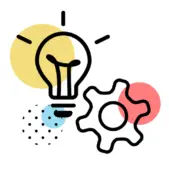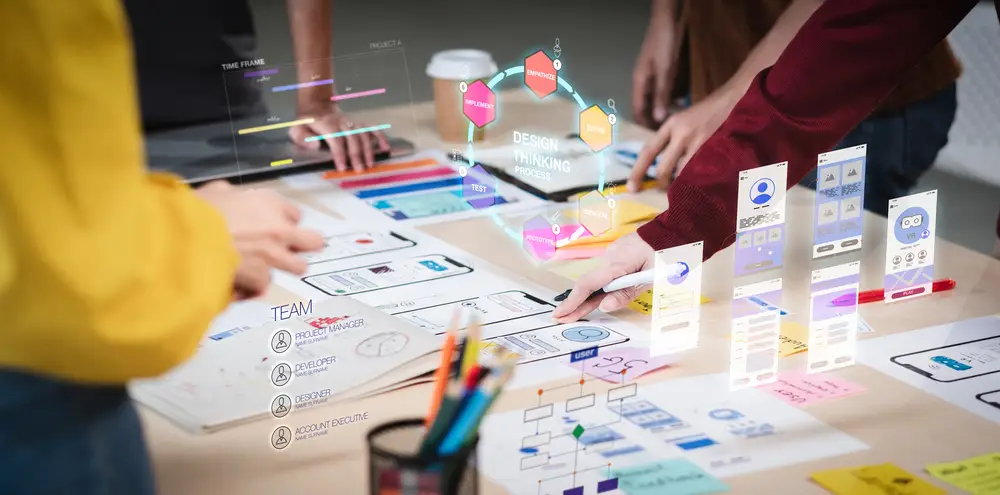- Measuring Success: Why Customer Success Goes Beyond Making a Sale
- How To Build Long-Term Loyalty With a Successful Client
- How UX Consulting Agencies Help Boost Project Success for Your Business
- How To Find a UX Design Agency That Works for Your Needs
- Creating Efficiencies and Velocity for Your Digital Project: How Agencies Help Optimize Client Company Workflow
- The Bottom Line: UX Project Optimization Leads to Customer Success
Businesses know how important it is to deliver a seamless customer experience (CX). Customer success, or customer success, is a specialized CX concept that focuses specifically on how businesses help customers get the most possible value when using their products or services.
It’s easy to conflate customer success with customer service, but there are important distinctions between the two concepts. Customer service strives to address problems and concerns in a friendly and efficient manner. However, it’s reactive by nature: service interactions only begin when a customer initiates them.
In contrast, customer success is proactive: it seeks to identify and solve potential problems before they occur. In so doing, customer success helps consumers make the most of a company’s products or services. By applying customer success principles strategically, businesses can deliver a superior customer experience, build stronger ties of loyalty, generate better word of mouth, and secure higher levels of repeat business.

Customer success is about much more than just completing a sale. This guide provides a deep dive into how healthy approaches to task and project management lead to customer success. Specifically, it covers:
- How to apply customer success principles to build customer loyalty
- The secret to aligning products and services with customers’ personal growth
- How user experience (UX) principles interact with customer success
- The importance of choosing a UX design company with proven customer success capabilities
- How to optimize and simplify UX workflows in support of customer success objectives
Measuring Success: Why Customer Success Goes Beyond Making a Sale
Some businesses continue to cling to the outdated idea that success ends with making a sale. But such viewpoints overlook the critical element of delivering a positive and ongoing customer experience.
Customer success contributes to a great CX by helping clients meet needs, solve problems, and achieve goals with your products or services. For instance, UpTop uses a combination of deep, targeted expertise and cutting-edge analytical tools to help clients better understand their customers. As a result, businesses can build better customer experiences.
Businesses that proactively work to help customers get the most from their purchases engage buyers on deeper, more meaningful levels. This then leads to higher satisfaction rates. Simply put, satisfied customers are much more likely to become repeat customers, and repeat customers often turn into loyal long-term customers.
How Businesses Benefit From Customer Success
It’s 100% possible to achieve business growth through customer success. After all, happy customers make businesses thrive. Customer success drives the kind of elevated satisfaction rates that generate buzz, fuel organic growth, and draw customers back time and again.
When used as a core element of a holistic and complete CX strategy, customer success can deliver outstanding returns on investment (ROI). Let’s look at some simple yet powerful examples of customer success strategies.
Business-Initiated Customer Outreach
In traditional customer service, businesses let their customers come to them with questions and problems. But customer success does the opposite. It guides businesses to reach out to clients proactively to ensure they’re satisfied with their purchase and able to access all its features.

Such communications can occur across any supported customer interaction channel, although email is particularly useful. Outreach efforts can:
- Offer helpful information and resources
- Provide deeper insights or instructions on how other customers obtained more value from their purchases
- Link customers to customer service channels
UpTop Perspective
When businesses reach out to customers first, they flip how customers and businesses usually interact. For instance, there’s less emphasis on troubleshooting. Instead, the business becomes a sort of consultant, which leads to a more collaborative relationship.
Metric-Driven Performance Monitoring
Specialized tech tools and customer success platforms can help businesses see when and how a customer uses their products. These platforms are especially relevant to products and services that involve customer onboarding. They let the business track the customer’s engagement with onboarding processes.
Healthy performance metrics indicate a smooth customer experience. Even in these cases, proactive outreach still helps because it builds trust and creates another avenue for engagement.
If your performance metrics show room for improvement, don’t wait for customers to come to you. Instead, reach out and help customers solve whatever problems they’re facing.
Personalized Interactions
Businesses should strive to personalize every customer interaction to the greatest possible degree. For example, if you use an email list as part of your digital marketing efforts, you can divide it into key customer segments and customize message content for each of them.
Personalization builds value into every customer interaction. It’s critical if you want to perfect customer journeys and nurture closer loyalty ties.
Relevant, Helpful Online Content
Businesses often use their online content to boost their search engine visibility. It’s true that doing so generates leads and helps businesses connect with prospects. But limiting your content strategy to search engine optimization (SEO) objectives can lead to missed customer success opportunities.
Your content must do more than market your business. It should also provide detailed, useful information about your products or services and how customers can get the most from them. Businesses can also make information guides and other supporting materials available and visible on their websites so customers can easily find what they need.
Soliciting and Responding to Feedback
A company’s customers are filled with important insights into steps the business could take to improve its products and services. Businesses can tap into this treasure trove of valuable information by soliciting feedback with surveys, questionnaires, and interviews.
From there, you can use the insights to improve your products and services and proactively respond to potential problems or concerns. Encourage customer participation in your feedback program by offering perks or rewards. Also, look for broad trends that persist across large sample sizes.
How To Build Long-Term Loyalty With a Successful Client
Customer engagement post-sale is one of the most important ways to build long-term loyalty through customer success. So, let’s look at some proven strategies you can use.
Data-Driven Buyer Personas
Buyer personas are profiles that represent the various types of consumers who could benefit from your products or services. It’s important to develop accurate buyer personas that are informed by both quantitative and qualitative data. Doing so helps businesses identify the motivations, goals, desires, and challenges that people in your target market face.

You can then customize your messaging to resonate with target consumers with greater precision. Ultimately, this supports the kind of superior customer experience that keeps buyers coming back.
Personalized Contact
Customers who voluntarily give you their email addresses are willing to receive marketing messages from you. So, reach out with personalized messages to guide them toward relevant products or services. This is a low-cost, high-impact way to nurture relationships.
Social Media Outreach
Consumers increasingly use social media channels to post feedback, submit complaints, and seek support. Businesses that provide quick, courteous, helpful responses create a public record of their service standards, which can build trust among both established and prospective customers. That trust is key to winning long-term clients and boosting customer success.
Offer Rewards for Referrals
Referral programs can magnify your customer loyalty efforts. For example, you could offer an existing customer a discount on future purchases for referring a new customer to the business. The business benefits twice: once from the new customer, and again from the customer who returns to claim their reward.
When properly managed and driven by enticing rewards, referral programs can snowball into huge customer gains.
Create a Loyalty Program
Loyalty programs are another proven way to earn repeat business. They take many forms but generally include one or more of the following:
- Special or early access to promotions, sales, or new products
- Tiered programs that deliver more savings as customers reach higher levels
- Points programs
- Birthday discounts (for consumer products)
Loyalty programs can create a sense that the customer is getting special, preferential treatment from the business. Such feelings are a powerful motivator, and long-term repeat business is a common result.
Supporting Client Growth With Your Brand
Businesses that make active efforts to help their customers grow, develop, and improve their lives forge strong and powerful connections with their patrons. When you foster alignment between your business, its branding, and customer success, you put yourself in a position to become a valued partner in your customers’ lives. Such relationships have incredible long-term resonance.
Businesses that link their branding to the growth and success of their customers also create a path to fostering a collaborative and positive internal workplace culture. This supports both a great customer experience and a rewarding employee experience. Basically, it delivers more continuity and cohesion and helps reduce recruitment and retention costs.
How UX Consulting Agencies Help Boost Project Success
For businesses that rely on a strong, carefully curated digital presence, UX consulting agencies can be a major asset. They’re also a helpful partner for building effective customer success programs. UX design is about much more than arranging digital elements on a webpage; it engineers the entire customer experience. Basically, it can mean the difference between making or not making a sale and retaining or losing a customer.
UX consulting for businesses can be particularly useful if:
- Your business lacks internal UX expertise or could benefit from a fresh, outside-in perspective.
- Internal efforts to improve UX design are negatively impacting productivity and operational efficiency.
- You want professional guidance on your UX testing and development strategies.
- You’d like to perform a complete, impartial audit of your digital assets to identify areas for refinement or improvement.
- You need help identifying the best UX strategy for a particular application.
Let’s explore other ways UX consulting firms can help businesses.
Optimize Customer Journeys
Customer success strategies are most effective when built on a sound and comprehensive understanding of the underlying customer journey. It begins with the consumer’s first awareness of a business and its brand. The journey then continues into post-purchase customer nurturing that encourages customer loyalty.

Optimizing the customer experience involves a process known as customer journey mapping. Journey mapping means creating a visual representation of each step in the customer’s journey. It also emphasizes the ongoing processes, customer needs, pain points, and brand perceptions that occur at each stage.
Use these strategies to create effective customer journey maps:
- Segment your customers by persona and create different journey maps for each group.
- Emphasize the capture of consumers at the top of your sales funnel by engaging them with appealing content, helpful information, special offers, or free trials.
- Pay particular attention to the middle of the sales funnel, which businesses often overlook. Emphasize personalized outreach, retargeting, and value-driven advertising.
- Make it easy for customers to access relevant product and service information at every stage of the journey.
You will build a more relevant and complete journey map by soliciting feedback from actual customers. Apply customer-submitted insights as you refine your journey mapping efforts with targeted improvements.
Build Efficient UX Project Design Processes
The UX process emphasizes continual product development. Agencies typically use their own unique variations on well-established standards, including four- and eight-step processes.
The Four-Step Process
Efficient, expert-led UX project design processes yield superior digital experiences. Basic iterations of the UX design process have four main steps:
- Discovery. Perform market research, user research, competitive research, and data analysis to map out a set of high-level project objectives.
- Strategy. Craft buyer personas, iterate concepts, specify value propositions, and workshop solutions to generate a cohesive UX design strategy.
- Design. Apply information architecture principles to create user flows, sitemaps, wireframes, and prototypes that reflect the underlying UX design strategy.
- Validation. Perform A/B and usability tests and apply analytics tools to validate designs and identify areas for improvement. Then, repeat the design and validation steps until the final results satisfy project objectives.
The Eight-Step Process
UX designers can also deploy a more detailed methodology that breaks the process down into eight steps instead of just four:
- Define the project. Begin with a clear, succinct statement that defines what the UX project is going to build and why it’s important.
- Perform research. This stage reflects the “discovery” step referenced above in the four-step process model.
- Analyze and strategize. UX designers harvest, organize, and assess the data and insights collected during the research stage. They then use this information to identify a cohesive strategy for achieving the project goals defined in the first step of the process.
- Design. At this stage, designers put their strategies into action by creating multiple design possibilities. The UX team will assess each design based on its information architecture quality, usability, and visual branding. It will then select a small number of designs to develop into prototypes.
- Build prototypes. This stage involves building out designs into detailed but rough working models that enable designers to carry out tests.
- Test. This step carries out the testing elements of the “validation” stage referenced above in the four-step model.
- Launch. After refining and finalizing the preferred design, the finished product is pushed live.
- Assess and reiterate. The UX design process doesn’t end with the launch of a live product. Ongoing monitoring and performance analysis can highlight areas for potential improvement, which can be incorporated into refined iterations.
Digital project efficiency is the key objective, no matter which process model a situation may demand. The sooner you’re able to launch a fully UX-optimized customer interface, the faster your results and success will follow.
Help Iterate Product Development
Iterative approaches to UX development cover five main process stages:
- Planning and analysis
- Design
- Implementation
- Testing
- Evaluation
Like the broader UX process, iterative design unfolds from insights that have been drawn from a logical progression through a series of defined steps. As a result, iterative approaches to development excel at identifying successes and filtering out approaches unlikely to yield desirable results.
UX experts recommend that projects embrace iterative approaches to UX development in scenarios involving:
- Understandable but vague project requirements
- Higher-risk elements or features that could undergo significant change over the course of the project lifecycle
- Large websites or mobile apps with complex architecture and large quantities of content and interactive features
- The potential for change in critical, core details
In other words, when UX project goals and scopes are elusive, difficult to define, or subject to change, iterative design processes tend to yield superior results.
Maximize Project Budget and ROI
Agencies specialize in maximizing project ROI through effective resource allocation and time management in UX projects. It’s difficult to overstate the agency’s role in workflow optimization. Many businesses simply don’t have the internal expertise required to complete UX projects with optimal efficiency and results.

What’s the secret? It begins with intelligent approaches to project research that save both time and money. For instance:
- Set clear, accurate objectives at the outset of the project to maximize focus and precision.
- Select quantifiable, measurable, and goal-oriented objectives.
- Have clearly defined use cases that illuminate said objectives, along with associated success criteria for each.
- Focus on core objectives and use integrated approaches that include both behavioral and attitudinal research.
- Leverage low-cost online tools like surveys and questionnaires to solicit user feedback.
- Make supplementary use of freely available, authoritative secondary research from governments, NGOs, market research firms, and business intelligence companies.
UX Project Roadmap Planning
From a UX perspective, long-term product development poses unique challenges. Priorities can change quickly, and businesses can’t always predict how much investment a product will need as it moves through the development lifecycle. This is where UX project roadmap planning can help.
A UX roadmap is a strategic plan that defines initiatives, goals, and the methods for reaching them. Let these best practices guide your roadmap development:
- Keep your roadmap up to date. For long-term projects, revisit your roadmap at least annually, if not more frequently. This will make it easier for you to allocate extra resources to maximum effect if they become available.
- Prioritize communication and accountability in UX projects. Communication and accountability originate with project leadership, but they also apply to UX partners and agencies. Each participant should know which aspects of the project they’re responsible for, what a successful implementation looks like, when results are due, and who makes which decisions.
- Ensure your UX development team has the right resources. Product development teams need full access to all relevant data and research. Check in with project managers regularly to make sure adequate funding, human resources, and tech tools are available.
When handled correctly, project road mapping ensures you make the right investments in the right places. UX design agencies can also help businesses manage their roadmaps, provided you select one with the requisite expertise.
Streamline Project Resource and Allocation
The efficient streamlining of project resources helps businesses boost their efficiency and returns on UX development and agency investments. Effective approaches to resource allocation also help project managers keep development tasks on time and on budget.
Notably, serious missteps in allocating project resources can have serious consequences:
- Project managers can become confused about what resources are available to them. It then becomes difficult or impossible for them to accurately track progress toward important milestones.
- Internal team members may become displaced or frustrated by the inefficiencies. This could prompt them to disengage from the task, duplicate efforts or inadvertently move on to other tasks.
- Serious inefficiencies can lead to project failure, ultimately causing the company to lose time, money, and potential customers.
Effective Approaches to Resource Allocation
To maximize your project ROI, you must efficiently and effectively allocate available resources. UX experts recommend following these tips and best practices:
- Create a complete list of all available assets and resources before you decide where to allocate any of them. Then, think about which resources make the best match for specific tasks and make allocation decisions accordingly.
- Consider utilization rates when tracking resource allocation. For instance, are certain resources or team members being underused or overused? Find ways to get more value from underused resources and reduce strain on overused resources to prevent burnout.
- Account and carefully plan for phases of the project that are going to be the most resource-intensive. This technique, known as resource leveling, helps project managers balance their use of resources during lower-intensity phases.
- Use “resource smoothing” strategies to identify unnecessary or inefficient actions, tasks, and steps. Streamline, combine, integrate, or eliminate those excesses to reduce the project’s completion time.
- Take advantage of intelligent software tools to track your use of resources and more effectively plan for unexpected bumps in the road.
UpTop Perspective
Businesses can also benefit by outsourcing some UX development tasks to specialized agencies with advanced insights and precise expertise. This liberates internal teams from the need to spend time and energy developing UX concepts that lie outside their experience and capabilities. Instead, they can focus on improving the company’s products, advancing its core mission, and identifying innovation opportunities.
How To Find a UX Consulting Agency That Works for Your Needs
Great UX can enhance your customer success efforts. But optimizing project impact and getting the best value for your UX investment requires a careful approach to partner selection. UX consulting agencies can help bring your business to the next level. Of course, not all agencies are the same.
At the start of the selection process, consider some key high-level factors. Depending on the nature of your project, this might include:
- The size of the agency’s team. Agencies with larger teams tend to have a more diverse array of perspectives and talents. However, larger teams also tend to be less agile. Niche and specialized projects can benefit from smaller, more carefully curated teams with targeted capabilities and relevant experience.
- The agency’s work environment. Perform research to see how satisfied employees are with their experiences. Low employee satisfaction ratings are one of the more underrated red flags in UX design agencies.
- Past client experiences. In addition to assessing the UX design agency’s portfolio, conduct your own inquiries into client experiences. Client-led testimonials supplied by third-party reviewers often deliver relevant insights.
UpTop Perspective
Early on in the selection process, you should also consider the agency’s philosophy on UX strategy and assess how well it matches your objectives. From there, you can begin evaluating candidates on their finer points.
Assess Your Goals and Scope of Work Needed
As a matter of practicality, you’ll need to define your project’s scope and objectives to ensure the agency partner you select can deliver the desired results. One easy way to achieve clarity on your project’s goals is to use the SMART method. Establish objectives that are:
- Specific
- Measurable
- Achievable
- Realistic
- Time-bound

Agencies worth partnering with can also help you define your project’s goals and scope, two critical elements. For example, you might solicit an agency’s guidance in performing a SWOT (strengths, weaknesses, opportunities, and threats) analysis to turn vague or loosely defined business objectives into an actionable set of steps.
Consider Past Projects Within the Agency’s Portfolio
As you shortlist a smaller number of candidates, collect and evaluate relevant samples from each UX design agency portfolio. You should see clear, direct links between the agency’s past work and your project, along with quantifiable metrics indicating a successful outcome.
You can also draw on elements of a UX audit to assess whether a given agency is the right fit for your project. When used by agencies, UX reviews excel at identifying specific problems, weaknesses, or areas for improvement. You can apply relevant UX review principles when choosing an agency to ensure they understand your industry, products, services, and business objectives.
Ask the agency for a high-level assessment of:
- The product’s purpose and value in the context of your business
- High-level ideas for improving product performance
- How your users or customers benefit from your products or services
- Potential strategies for evaluating and refining the product’s current UX performance
In considering the agency’s responses, you’ll want to look for evidence that the agency recognizes the context-specific importance of the project. Also, be sure the agency has clear, actionable ideas for meeting your project goals within a reasonable time frame and budget.
Check How They Resolve Potential UX Challenges
Potential clients should also research how a UX agency deals with potential setbacks and challenges throughout a project’s lifecycle. Here, you’ll want assurances that the agency takes a user-centric approach to design. User-centric strategies root every design decision, both major and minor, in the intended user’s needs, desires, and preferences.
Surprisingly, a McKinsey & Company report found that only about half of all businesses conduct user research before launching a UX project. Research is critical to user-centric design. If an agency downplays the importance of project-specific research or seems to favor half-measures, you may want to reconsider the partnership.
Also, look into how the agency communicates with clients. Agencies sometimes take full charge of projects, reducing their paying clients to the role of passive spectators. This can lead to communication breakdowns and unsatisfactory results, especially if initial strategies turn out to be misaligned or flawed. Instead, look for agencies who consider their clients full partners in each project and work hand-in-hand with clients to get everyone on the same page.
Finally, ensure the agency adheres to best practices for testing, auditing, and benchmarking. Reputable agencies should have expert fluency in all the following areas:
- User research and testing
- UX auditing
- Usability studies and benchmarking
- Wireframe, prototype, and mockup design
- User journeys, experience mapping, and buyer personas
- Information architecture and site mapping
This checklist ensures the agency has the in-house expertise required to both meet and overcome the setbacks and challenges that accompany virtually every UX project.
Scalability and Long-Term Collaborations
Successful long-term UX collaborations are built on three key factors:
- Alignment between the agency and client
- Strong, effective lines of cross-communication
- Desirable results

Many businesses find that UX agencies with strong internal cultures of innovation and creativity make for excellent long-term partners. These characteristics instill agencies with evergreen tools for responding to dynamic changes that affect economies, industries, and technologies.
Agencies that can offer scalable UX solutions also tend to be strong long-term partners. Agile scalability stems from sound practices in areas such as:
- Defining user flows and efficiently identifying core, critical product features
- Systemic and modular design consistency
- Product performance and accessibility optimization
- Careful, thorough, and results-oriented product testing
- Iterative approaches to UX design
UpTop Perspective
Good UX agencies will also be able to anticipate the needs of future users and account for them in present-day strategic approaches to customer success. If you find an agency that helps you stay ahead of the trend curve, your business is more likely to generate continuous benefits from stable and predictable investments.
Red Flags That Signal You Have the Wrong UX Consulting Agency
Clients should always be on the lookout for red flags in UX design agencies. In some cases, you can detect these warning signs before you enter into a formal partnership with an agency. Unfortunately, in other situations, the red flags only become apparent once you begin collaborating on a project.
Here are some key warning signs to watch for:
- The agency takes a checklist approach to the design process and doesn’t spend enough time on project-specific research.
- Proposed processes, plans, and strategies are vague, disjointed, unclear, or ill-defined.
- They marginalize your input or produce results that don’t match your stated goals or preferences.
- The agency personnel assigned to your project constantly changes. This can signal internal dysfunction at the agency, which will likely lead to unsatisfactory results.
- The UX design agency portfolio shows little evidence of evolution or change over time in response to shifting best practices and user preferences.
- Deadlines pass without results.
- The agency minimizes or dismisses your feedback and tries to talk you out of making necessary changes or adjusting processes or strategies to better meet your goals.
If you spot these red flags before you finalize an agency partnership, you may want to rethink your choice and look for an alternative. But if warning signs only begin to appear after you’ve started working with an agency, you generally have two options: communicate your concerns and try to resolve them, or hire a different partner.
When communicating concerns, ask the agency to propose specific remediation actions. Then, monitor progress toward those actions. If the issues persist, terminating the relationship may be your only viable option.
Creating Efficiencies and Velocity for Your Digital Project: How Agencies Help Optimize Client Company Workflow
Efficient digital project management creates the kind of momentum and velocity that brings work to timely, successful, and on-budget conclusions. For effective and streamlined approaches to workflow management,
- Optimize cross-project collaboration and resource allocation
- Maintain a clear accountability chain
- Consider both the strengths and limitations of individual team members when assigning and delegating tasks
- Automate repetitive tasks in UX to improve efficiency and reduce the likelihood of human error

UpTop further optimizes digital workflows and secures clients’ trust by adhering to specific best practices for project efficiency – one of which is task completion time, a critical element of efficiency.
Understanding the Challenge of Task Completion Time
Managing the task completion time is essential to bringing UX projects to efficient, on-schedule conclusions. Of course, challenges always occur, usually from:
- Tedious, stressful, or repetitive tasks that workers aren’t eager to complete
- Inefficient approaches to multitasking, which lead to few or no tasks being completed properly or on time
- Misaligned task prioritization and project disorganization
- Project burnout and an inability to say “no” to peripheral tasks that add to the workload
Fortunately, project managers and team members can implement easy and effective solutions. Starting with a clear, specific, and actionable plan helps personnel stay focused and move efficiently toward goal completion.
Plans should include a detailed, structured breakdown of each task and its constituent parts. The strategy of breaking large, complex tasks down into smaller, simpler parts is a highly effective practical and psychological tool.
The Role of Agency Teams in Reducing Task Completion Time
Clients primarily hire external agencies to leverage their UX and digital design expertise, but reputable agencies offer another important benefit. Their project-focused experience means they have advanced insights into ways to improve efficiency and reduce task completion time without compromising the quality of their results.
Here are some ways agencies optimize task-based time expenditures:
- They implement the project management methodology best suited to the agency’s working model. Common methodologies include the Scrum, Kanban, and Waterfall processes, each of which has specific use-case scenarios.
- They invest in employee development programs that help team members better understand their colleagues and manage their own behaviors in team-oriented settings in a healthier, more sustainable manner. Collegial, supportive working environments also tend to be the most efficient.
- They automate repetitive tasks in UX by making strategic investments in time-saving software platforms and tech tools.
What’s more, leveraging external time efficiency expertise helps businesses achieve desirable outcomes on shorter timelines. It maximizes ROI and expedites the client’s journey to realizing the customer satisfaction and loyalty benefits that follow from superior UX.
Optimization Strategies for Streamlining Task Completion Time
External agencies can also work with their clients to conduct reviews and assess how their internal processes may be negatively impacting their CX and customer success goals. For example, UpTop uses service design maps that visualize connections between critical CX touchpoints and internal business operations. It’s proven highly effective in diagnosing the underlying causes of stubborn impediments to building a better customer experience.
From a project management perspective, the following techniques and strategies can also yield beneficial results:
Automate Repetitive Tasks
Automating repetitive tasks saves both time and resources. Crucially, it also makes employees better able to focus on more productive work.
AI has sparked a generation of advanced automation software that can efficiently automate tasks with important CX and customer success applications. Specifically, this software can:
- Schedule and execute social media posts
- Distribute personalized marketing emails
- Conduct sales analytics and forecasting
- Update and maintain customer relationship management (CRM) entries

Targeted investments in automation can pay dividends in the form of major productivity improvements. These typically follow the liberation of your workforce from tedious and repetitive tasks.
Boost Employee Adoption
Businesses benefit when employees adopt new productivity tools and efficiency processes. Enhancing employee UX adoption can help businesses reduce costs, save time, and inspire the confidence of their clients. This, in turn, improves client loyalty and helps the business build and maintain competitive advantages.
Businesses can use the following strategies to encourage employees to embrace innovative technologies and processes:
- Choose tools that are clearly relevant to the difficulties and challenges employees face.
- Create strategic plans for rolling out and integrating new technologies into established workflows.
- Provide training and support to improve employee proficiency with new technologies and ways of managing or completing tasks.
- Make training engaging and consider building in individualized rewards for completing it.
Managers should then monitor employee progress with new technologies and follow up proactively to address problems or pain points.
Simplify Tasks and Workflows
Task completion processes and workflows often become cluttered with excesses and inefficiencies. To clear that clutter, organizations can map out current processes, identify areas where work could be simplified or streamlined, and draw on lean management principles to eliminate productivity barriers.
Technology can also help. In addition to automation tools, businesses can use project and task management platforms that generate user-friendly workflow charts and visualizations. This helps break large, complicated tasks down into smaller parts so the entire system becomes simpler.
Maximize Communication and Accountability
Communication and accountability are both paramount to project success and work hand-in-hand. Communicating clear expectations to team members can include establishing accountable responsibilities at the outset of a project.
To improve internal communications among team members, try these proven strategies:
- Ensure all communications have a clear, work-related purpose.
- Eliminate unnecessary meetings.
- Favor one-on-one approaches to interpersonal interaction whenever possible.
- Establish a single go-to communication channel and ensure all critical communications are distributed through it.

Team members can also help improve communication by building good habits. For example, they can provide regular progress updates to project managers or supervisors to ensure tasks are evolving productively.
The Bottom Line: UX Project Optimization Leads to Customer Success
Customer success emerges organically from an optimized customer experience, and an optimized CX is much easier to achieve in a healthy, efficient organization. Businesses that lack the in-house expertise or resources to build the kind of UX and CX that leads to customer success can turn to external partners for help.
UpTop is ideally situated to assist you with these efforts. In addition to serving clients as an accomplished, user-centric UX design agency, we also help businesses improve their internal processes and workflow management structures to boost their efficiency, performance, and financial results.
Contact UpTop today to get started with a UX evaluation. We can uncover ways to boost your business performance through automation, streamlining, and efficiency improvements.



